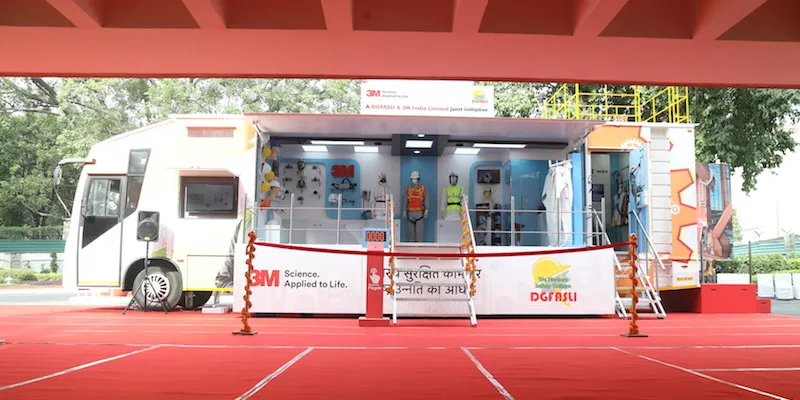3M drives industrial safety awareness for millions of workers
In September last year, the bodies of two manual labour workers were found in a tank at Anna University premises. The cause of death was later ruled as inhalation of toluene, a benzene derivative they were using to seal the tank. The tank had just a single opening, and failure to take safety precautions meant that the men’s fate was sealed the moment they got into the suffocating space. They were dead in four hours, adding to the country’s grim statistics of poor industrial safety.
This is not an isolated incident. Callous employers and contractors take advantage of people’s economic vulnerabilities. We see examples all around us: from painters who renovate our homes to welders in factories to the window cleaners whom we see precariously balanced on the other side of our air-conditioned offices.
In a bid to raise awareness among the labour force on the importance of safety measures and proper equipment in the workplace, 3M, in association with the Directorate General, Factory Advice Service & Labour Institutes (DGFASLI), Ministry of Labour and Employment, launched the Audhyogik Suraksha Rath (mobile industrial safety training van). As part of this initiative, two mobile safety units will travel all over the country and educate workers on the importance of safety in the workspace. Over the next three years, the vans will cover one million industrial workers, raising awareness on industrial safety and health through training programmes with the message: Safety First.

Appropriately enough, the vans were flagged off in New Delhi on Vishwakarma Day, September 17, 2017, by Union Minister of State for Labour and Employment Santosh Gangwar. Addressing a gathering of over 1,000 industrial workers and other stakeholders, the minister said, “Every day, thousands of workers get injured, resulting in loss of limbs and lives, mainly due to the negligence of following proper occupational safety procedures and lack of knowledge on the correct usage of PPEs (personal protective equipment) for various industrial hazards. These Audhyogik Suraksha Raths will help … ensure the safety and well-being of the workers at the workplace.”
As part of the awareness-raising campaign, over 200 delegates attended a workshop, Mapping of the OSH (Occupational Safety and Health) Awareness in the Western Region, conducted in the presence of Dr. Avneesh Singh, Director General, DGFASLI, and Debarati Sen, Managing Director, 3M India Region (India & Sri Lanka).
Underscoring the necessity for the right protection equipment at the workplace, Sen said, “This is a moment of pride for 3M as we join hands with the Government of India for a singular cause that is of utmost importance as we navigate the growth accelerator phase of ‘Make in India’. Our interest in this subject stems from our three decades of experience working with industrial workers in India, in the area of personal protective equipment, where we realised a compelling need to create awareness on occupational hazards and safety.”
The first Suraksha Rath has already trained over 6,000 industrial workers in north India so far. The second has travelled across various industrial sectors in the western region of the country, and has already reached Mumbai.
On board these mobile units, 3M's network of experts will conduct safety training, demonstrations, education of workers and safety officers, besides talking about occupational safety and prevention of injuries and disease. Another crucial aspect is helping the worker or employer pick the right PPE such as hearing protection earplugs, eye and face protection gear, respirators and full-body fall protection harnesses (and much more), keeping in mind the type of industry, the operating area and nature of contaminants if any.
DGFASLI Director-General Dr. Singh said, “I would like to further stress upon the need to impart training to the unskilled labourer coming from rural India to work at various locations…especially [in the] construction sector. The Audhyogik Suraksha Rath will help in generating awareness amongst [them].”
According to DGFASLI, there were 1,383 fatal and 28,441non-fatal accidents at registered factories in 2012. There are no clear statistics on what the scenario is in the rest of the unorganised sector, but the numbers are likely to be far greater.
Sadly, as seen in the video above, many think this is par for the course and an inevitable occupational hazard. From burns to chronic lung infections or even far worse, men and women find themselves in the path of great danger every day. Such fatalism can be seen in the belief that mere tying of a cloth over their faces or using makeshift protection for their hands and feet is enough to ward off toxins and hazardous particles.
In cases of industrial injury, their recourse to treatment is often limited. According to a report by the Hong Kong-based Asia Monitor Resource Centre, occupational health in India has to compete with primary and curative health for its budget. While India allots a mere 4 percent of its gross domestic product (GDP) on healthcare, some 75 percent of this is spent on curative health. The same report points out that there are only around 1,125 qualified occupational health professionals and 100 qualified hygienists in India as against a requirement of over 8,000 qualified occupational health doctors.
The economic implications of industrial accidents and injuries are significant. To put it in perspective, China estimated that the loss of productivity due to injuries and accidents in the workplace was close to $38 billion. (Source: EPW)
Clearly, we have a long way to go. The first step in this direction is awareness and the 3M campaign aims to do just that.








